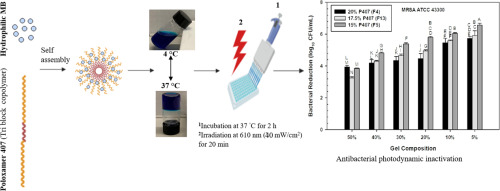当前位置:
X-MOL 学术
›
J. Photochem. Photobiol. B Biol.
›
论文详情
Our official English website, www.x-mol.net, welcomes your feedback! (Note: you will need to create a separate account there.)
Development of thermosensitive hydrogel containing methylene blue for topical antimicrobial photodynamic therapy.
Journal of Photochemistry and Photobiology B: Biology ( IF 5.4 ) Pub Date : 2020-01-07 , DOI: 10.1016/j.jphotobiol.2020.111776 Brian Leung 1 , Priyanga Dharmaratne 2 , Wei Yan 3 , Ben C L Chan 4 , Clara B S Lau 4 , Kwok-Pui Fung 2 , Margaret Ip 5 , Sharon S Y Leung 3
Journal of Photochemistry and Photobiology B: Biology ( IF 5.4 ) Pub Date : 2020-01-07 , DOI: 10.1016/j.jphotobiol.2020.111776 Brian Leung 1 , Priyanga Dharmaratne 2 , Wei Yan 3 , Ben C L Chan 4 , Clara B S Lau 4 , Kwok-Pui Fung 2 , Margaret Ip 5 , Sharon S Y Leung 3
Affiliation

|
Due to the emergence of antibiotic resistance, antimicrobial photodynamic therapy (aPDT) has recently been demonstrated as a promising alternative to antibiotics to treat wound infections caused by multidrug-resistant (MDR) pathogens. This study aimed to evaluate the bacterial killing efficiency of aPDT mediated by methylene blue (MB) loaded thermosensitive hydrogels against methicillin-resistant Staphylococcus aureus (MRSA). Box-Behnken Design method was employed to investigate the impacts of the polymer compositions, Poloxamer 407, Poloxamer 188 and Carbopol 934P, on the gelation temperature (Tsol-gel) and release rate of MB. The viscosity and in vitro bacterial killing efficiency of three selected formulations with Tsol-gel ranged 25-34 °C and MB release in 2 h (the incubation time used for aPDT experiment) ≥ 70%, were assessed. The viscosity was found to increase with increasing P407 content and increasing total gel concentration. In the in vitro aPDT experiment, all tested MB-hydrogels demonstrated >2.5 log10 colony forming unit (CFU) reduction against three clinical relevant MRSA strains. Interestingly, the bacterial reduction increased with decreasing amount of gel added (reduced MB concentration). This was possibly attributed to the increased viscosity at higher gel concentration reducing the diffusion rate of released MB towards bacterial cells leading to reduced aPDT efficiency. In summary, aPDT with the thermosensitive MB hydrogel formulations is a promising treatment strategy for wound infections.
中文翻译:

含有亚甲基蓝的热敏水凝胶的开发,用于局部抗菌光动力疗法。
由于出现了抗生素抗药性,最近已证明抗微生物光动力疗法(aPDT)是治疗由多药耐药(MDR)病原体引起的伤口感染的抗生素的有希望的替代方法。这项研究旨在评估载有亚甲蓝(MB)的热敏水凝胶对耐甲氧西林的金黄色葡萄球菌(MRSA)介导的aPDT的杀细菌效率。采用Box-Behnken设计方法研究聚合物组合物Poloxamer 407,Poloxamer 188和Carbopol 934P对胶凝温度(Tsol-gel)和MB释放速率的影响。评估了三种选择的Tsol-gel制剂的粘度和体外细菌杀灭效率,其范围在25-34°C和MB在2小时内释放(用于PDT实验的孵育时间)≥70%。发现粘度随着P407含量的增加和总凝胶浓度的增加而增加。在体外aPDT实验中,针对三种临床相关MRSA菌株,所有测试的MB-水凝胶均显示> 2.5 log10菌落形成单位(CFU)减少。有趣的是,细菌减少随着凝胶添加量的减少(MB浓度降低)而增加。这可能归因于在较高凝胶浓度下粘度的增加,降低了释放的MB向细菌细胞的扩散速率,从而导致aPDT效率降低。总之,具有热敏性MB水凝胶制剂的aPDT是一种有前途的伤口感染治疗策略。针对三种临床相关的MRSA菌株减少了5 log10菌落形成单位(CFU)。有趣的是,细菌减少随着凝胶添加量的减少(MB浓度降低)而增加。这可能归因于在较高凝胶浓度下粘度的增加,降低了释放的MB向细菌细胞的扩散速率,从而导致aPDT效率降低。总之,具有热敏性MB水凝胶制剂的aPDT是一种有前途的伤口感染治疗策略。针对三种临床相关的MRSA菌株减少了5 log10菌落形成单位(CFU)。有趣的是,细菌减少随着凝胶添加量的减少(MB浓度降低)而增加。这可能归因于在较高凝胶浓度下粘度的增加,降低了释放的MB向细菌细胞的扩散速率,从而导致aPDT效率降低。总之,具有热敏性MB水凝胶制剂的aPDT是一种有前途的伤口感染治疗策略。这可能归因于在较高凝胶浓度下粘度的增加,降低了释放的MB向细菌细胞的扩散速率,从而导致aPDT效率降低。总之,具有热敏性MB水凝胶制剂的aPDT是一种有前途的伤口感染治疗策略。这可能归因于在较高凝胶浓度下粘度的增加,降低了释放的MB向细菌细胞的扩散速率,从而导致aPDT效率降低。总之,具有热敏性MB水凝胶制剂的aPDT是一种有前途的伤口感染治疗策略。
更新日期:2020-01-07
中文翻译:

含有亚甲基蓝的热敏水凝胶的开发,用于局部抗菌光动力疗法。
由于出现了抗生素抗药性,最近已证明抗微生物光动力疗法(aPDT)是治疗由多药耐药(MDR)病原体引起的伤口感染的抗生素的有希望的替代方法。这项研究旨在评估载有亚甲蓝(MB)的热敏水凝胶对耐甲氧西林的金黄色葡萄球菌(MRSA)介导的aPDT的杀细菌效率。采用Box-Behnken设计方法研究聚合物组合物Poloxamer 407,Poloxamer 188和Carbopol 934P对胶凝温度(Tsol-gel)和MB释放速率的影响。评估了三种选择的Tsol-gel制剂的粘度和体外细菌杀灭效率,其范围在25-34°C和MB在2小时内释放(用于PDT实验的孵育时间)≥70%。发现粘度随着P407含量的增加和总凝胶浓度的增加而增加。在体外aPDT实验中,针对三种临床相关MRSA菌株,所有测试的MB-水凝胶均显示> 2.5 log10菌落形成单位(CFU)减少。有趣的是,细菌减少随着凝胶添加量的减少(MB浓度降低)而增加。这可能归因于在较高凝胶浓度下粘度的增加,降低了释放的MB向细菌细胞的扩散速率,从而导致aPDT效率降低。总之,具有热敏性MB水凝胶制剂的aPDT是一种有前途的伤口感染治疗策略。针对三种临床相关的MRSA菌株减少了5 log10菌落形成单位(CFU)。有趣的是,细菌减少随着凝胶添加量的减少(MB浓度降低)而增加。这可能归因于在较高凝胶浓度下粘度的增加,降低了释放的MB向细菌细胞的扩散速率,从而导致aPDT效率降低。总之,具有热敏性MB水凝胶制剂的aPDT是一种有前途的伤口感染治疗策略。针对三种临床相关的MRSA菌株减少了5 log10菌落形成单位(CFU)。有趣的是,细菌减少随着凝胶添加量的减少(MB浓度降低)而增加。这可能归因于在较高凝胶浓度下粘度的增加,降低了释放的MB向细菌细胞的扩散速率,从而导致aPDT效率降低。总之,具有热敏性MB水凝胶制剂的aPDT是一种有前途的伤口感染治疗策略。这可能归因于在较高凝胶浓度下粘度的增加,降低了释放的MB向细菌细胞的扩散速率,从而导致aPDT效率降低。总之,具有热敏性MB水凝胶制剂的aPDT是一种有前途的伤口感染治疗策略。这可能归因于在较高凝胶浓度下粘度的增加,降低了释放的MB向细菌细胞的扩散速率,从而导致aPDT效率降低。总之,具有热敏性MB水凝胶制剂的aPDT是一种有前途的伤口感染治疗策略。


























 京公网安备 11010802027423号
京公网安备 11010802027423号